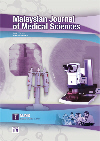
|
Malaysian Journal of Medical Sciences
School of Medical Sciences, Universiti Sains Malaysia
ISSN: 1394-195X
Vol. 17, No. 1, 2010, pp. 44-48
|
 Bioline Code: mj10008
Bioline Code: mj10008
Full paper language: English
Document type: Short Communication
Document available free of charge
|
|
|
Malaysian Journal of Medical Sciences, Vol. 17, No. 1, 2010, pp. 44-48
| en |
Angioarchitecture of Brain Arteriovenous Malformations and the Risk of Bleeding: An Analysis of Patients in Northeastern Malaysia
Kandai, Shibani; Abdullah, Mohd Shafie & Naing, Nyi Nyi
Abstract
Background: Central nervous system arteriovenous malformation (AVM) is a vascular
malformation of the brain and involves entanglement of veins and arteries without an intervening
capillary bed. Affecting predominantly young male patients, AVM presents with different clinical
manifestations namely headache, seizures, neurological deficit and intracranial haemorrhage. The
patients who present acutely with intracranial bleeding have a significant morbidity and mortality.
The aim is to study the angioarchitecture of brain AVM (BAVM) and determine the risk factors for
intracranial bleeding. Ultimately, the goal of the study is to look for the association between volume
of haematoma and architecture of BAVM.
Methods: A cross-sectional study of 58 patients was conducted at the Hospital Universiti Sains
Malaysia. Data were collected over a period of seven years (2000 to 2007) to look for the association
between the angioarchitecture of brain arteriovenous malformations (BAVM), haemodynamics and
the natural history and risk of intracranial haemorrhage.
Results: BAVM was predominantly found in young male patients in 65.5%. Small nidal size
(P-value 0.004), deep location (P-value 0.003) and deep venous drainage (P-value 0.006) were
found to be significant factors contributing to intracranial haemorrhage. All patients with coexisting
intranidal or prenidal aneurysms presented with intracranial haematoma.
Conclusion: The angioarchitecture of BAVM like nidal size, deep location and deep venous
drainage can predict the risk of intracranial bleeding and can help in the management of high risk
patients without any delay. Small sized and deep seated lesions have a diffuse type of intracranial
bleed which eventually need more attention to the managing team as diffuse haematoma indicates
more insult to brain.
Keywords
angioarchitecture, brain arteriovenous malformation, intracranial haemorrhage, stroke, medical sciences
|
| |
© Copyright 2010 - Malaysian Journal of Medical Science
Alternative site location: http://www.medic.usm.my/publication/mjms/
|
|
